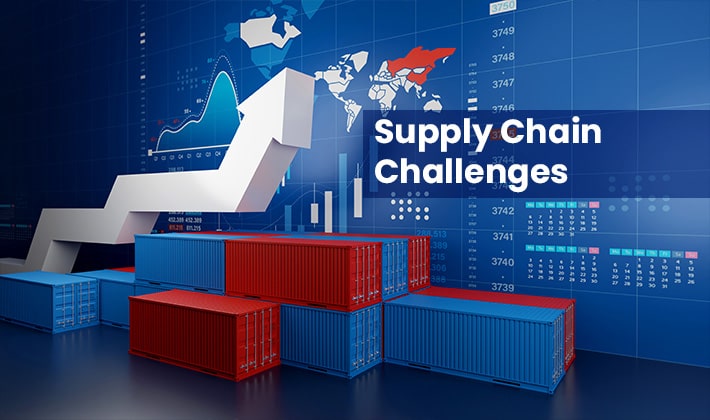
The dynamics of the global economy are transforming rapidly, and the logistics industry is no exception. As we step into 2024, the problems of supply chain management are more pronounced and multifaceted than ever before. From global supply chain challenges to issues of supply chain management at the micro-level, companies must adapt and evolve to stay competitive. At nVision Global, we’re here to guide you through these changing tides.
Unpacking Supply Chain Challenges
Among the myriad issues of supply chain management, some stand out more significantly in 2024. These problems in supply chain management range from technological integration, demand forecasting, and risk management, to sustainability and ethical considerations. As supply chains continue to globalize, these challenges only grow in complexity and scale.
The Global Supply Chain Challenges of 2024
The ongoing ripple effects of the global pandemic, coupled with the disruptive influence of technology, have created a new set of global supply chain challenges for 2024. Businesses must now contend with uncertainties in global markets, regulatory changes, trade restrictions, and the complexities of digital transformation.
- Geographic Unpredictability
Global supply networks are still being impacted by geopolitical conflicts and trade disputes. Tariffs, sanctions, and protectionism are examples of policies that obstruct the flow of materials and goods, causing businesses to reconsider their sourcing plans and look for new markets. The complexity and danger of supply chain operations are increased by the erratic and unpredictable nature of these geopolitical processes.
- Changes to Trade Agreements
Global trade accords have been evaluated in the post-pandemic era. Supply chain configurations have had to be modified as a result of the emergence of regional trade blocs like the Comprehensive and Progressive Agreement for Trans-Pacific Partnership (CPTPP) and the Regional Comprehensive Economic Partnership (RCEP), as well as changes to already-existing agreements like the North American Free Trade Agreement (NAFTA) becoming the United States-Mexico-Canada Agreement (USMCA). In order to optimize their supply chain strategies, businesses must traverse the shifting landscape of trade agreements.
- Supply Chain Digitization
The digital transformation of supply chains is both a solution and a challenge. On the one hand, digitalization presents chances for boosted visibility, effectiveness, and teamwork. Real-time tracking, demand forecasting, and inventory optimization are made possible by technologies like blockchain, IoT, AI, and big data analytics. However, the adoption of these technologies necessitates large financial outlays, modifications to the IT infrastructure, and security precautions. Businesses must balance implementing digital technologies with reducing related risks.
- Transportation and Logistics Bottlenecks
In 2024, the demand for the infrastructure of logistics and transportation has remained a problem. The transportation of goods has been hampered by port congestion, container shortages, and increasing freight prices, leading to delays and higher expenses. These bottlenecks are caused by a number of factors, including a labor shortage, capacity limitations, and an imbalance between supply and demand. Businesses are looking into alternate modes of transportation, optimizing routes, and enhancing their connections with logistics partners to lessen the impact.
- Sustainability in the Environment
Global supply chains have begun to place more emphasis on sustainable business practices and environmental concerns. Transparency, smaller carbon footprints, and ethical sourcing are becoming more and more in demand from customers and regulatory organizations. In-depth supply chain mapping, green logistics techniques, the use of renewable energy sources, and collaboration with eco-friendly suppliers are all necessary to meet these objectives. For organizations, striking a balance between sustainability, cost-effectiveness, and profitability continues to be a difficult task.
- The resilience of the supply chain
The COVID-19 pandemic has brought to light how susceptible to interruptions the world’s supply systems are. The pandemic has shown the weakness of centralized and lean supply chain approaches, exposing everything from staff shortages to lockdown procedures to transportation constraints. Businesses are adopting resilience tactics in response, including nearshoring, dual sourcing, and stockpiling buffers. However, the move towards resilience frequently comes at the expense of more inventory, more expensive operations, and significant cost-efficiency trade-offs.
Solutions to Supply Chain Problems
While these challenges may seem daunting, there are innovative solutions to supply chain problems. Advanced data analytics can offer improved demand forecasting, while the smart adoption of technologies such as AI, blockchain, and IoT can streamline operations and enhance transparency. Sustainable practices and ethical sourcing can also help businesses align with growing customer expectations and regulatory pressures.
At nVision Global, we offer advanced supply chain solutions designed to address these challenges. Our technology-driven approach ensures seamless integration, improved visibility, and data-driven decision-making, empowering businesses to turn supply chain challenges into competitive advantages.
Conclusion
In the face of burgeoning supply chain challenges, businesses must be prepared to adapt, innovate, and overcome. At nVision Global, we understand these challenges and provide robust, technology-driven solutions tailored to the unique needs of your business.
Supply chain management is no longer a back-office function. It’s a strategic initiative that directly impacts a business’s bottom line and customer satisfaction. By proactively addressing the challenges of supply chain management, businesses can position themselves for growth and success in 2024 and beyond.
As a leader in supply chain management solutions, nVision Global is here to guide you through these challenges and help you emerge stronger. Let’s turn your supply chain into a strategic asset – contact us today to learn more.